Computer Architecture: Microprocessor Evolution and Systems
VerifiedAdded on 2020/10/22
|10
|2895
|347
Report
AI Summary
This report provides a comprehensive overview of computer architecture, beginning with an introduction to the field and its core components. It delves into the evolution of microprocessors, tracing their development from the 1970s to the 1990s, highlighting key advancements such as the introduction of 4-bit, 8-bit, 16-bit, 32-bit, and 64-bit processors, along with the companies and technologies that drove these changes. The report then examines the concepts of multiprocessors and multicores, explaining their functionalities, differences, advantages, and communication architectures like message passing and shared memory. It differentiates between multiprocessor systems, which utilize a single operating system to coordinate multiple CPUs, and multicore processors, which integrate multiple independent processing units within a single chip. The report also discusses the benefits of multiprocessors, such as increased reliability and throughput, and the role of multicore processors in enabling parallel computing and enhancing system performance in various applications. Finally, it summarizes the rapid progress in microprocessor speed and size, emphasizing the shift towards more powerful and efficient computing systems.
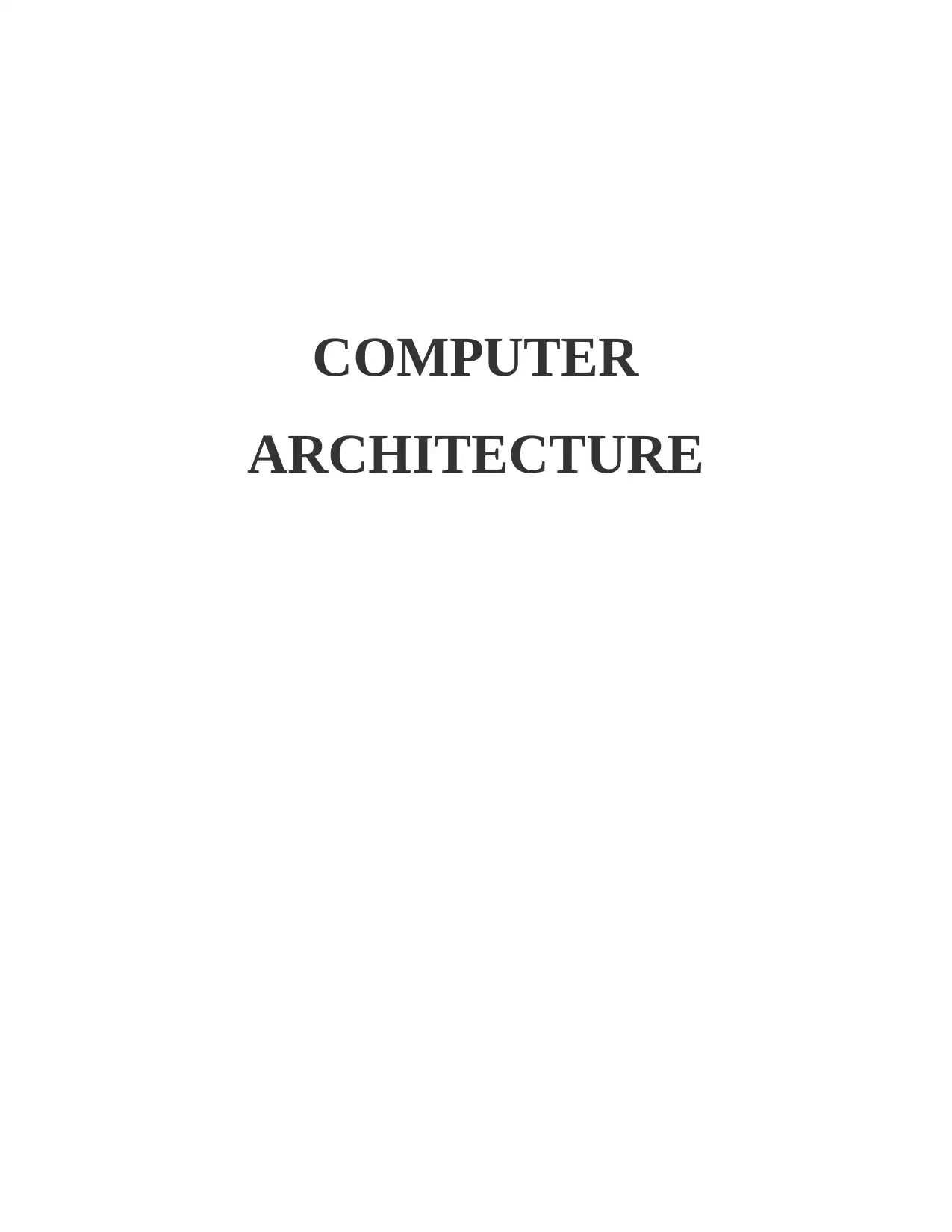
COMPUTER
ARCHITECTURE
ARCHITECTURE
Paraphrase This Document
Need a fresh take? Get an instant paraphrase of this document with our AI Paraphraser
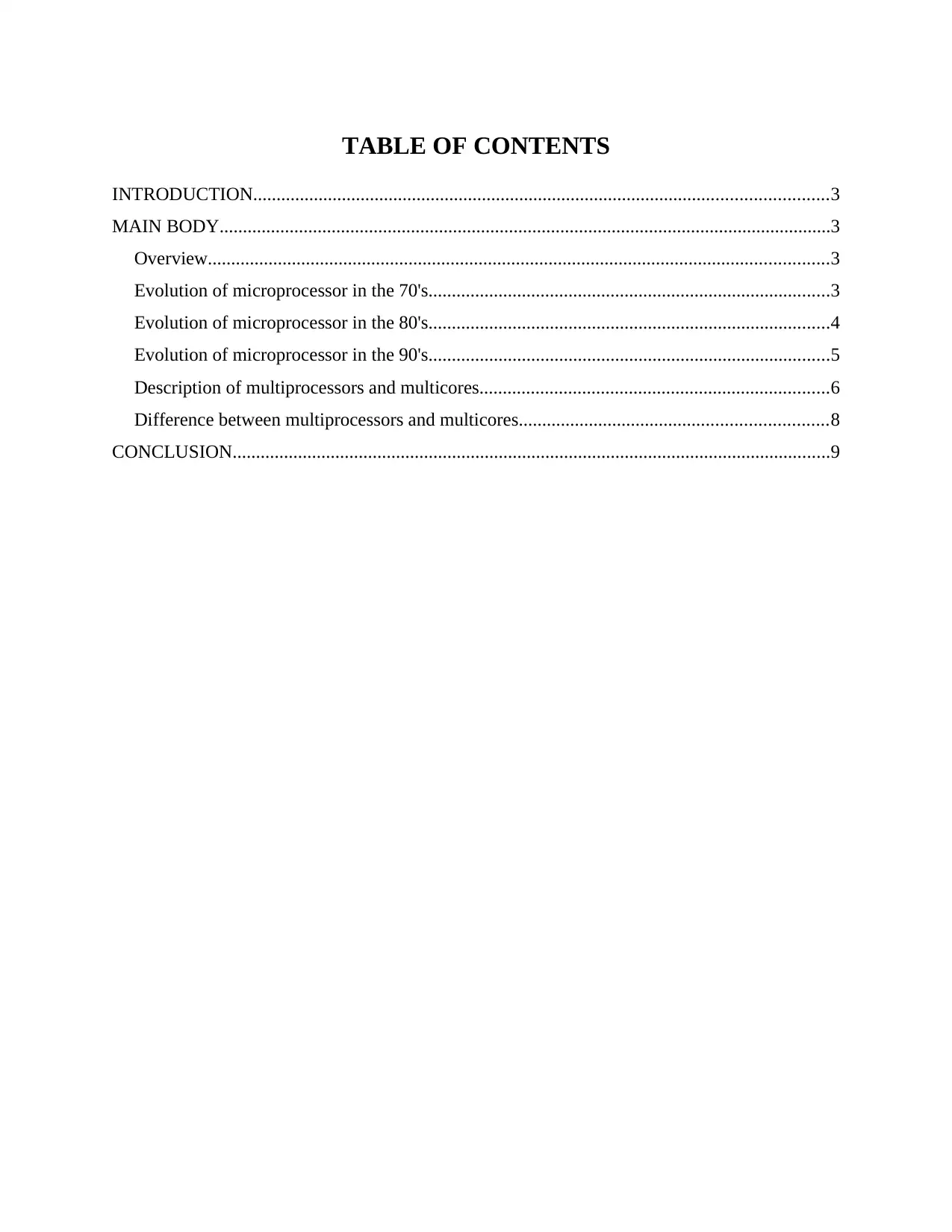
TABLE OF CONTENTS
INTRODUCTION...........................................................................................................................3
MAIN BODY...................................................................................................................................3
Overview.....................................................................................................................................3
Evolution of microprocessor in the 70's......................................................................................3
Evolution of microprocessor in the 80's......................................................................................4
Evolution of microprocessor in the 90's......................................................................................5
Description of multiprocessors and multicores...........................................................................6
Difference between multiprocessors and multicores..................................................................8
CONCLUSION................................................................................................................................9
INTRODUCTION...........................................................................................................................3
MAIN BODY...................................................................................................................................3
Overview.....................................................................................................................................3
Evolution of microprocessor in the 70's......................................................................................3
Evolution of microprocessor in the 80's......................................................................................4
Evolution of microprocessor in the 90's......................................................................................5
Description of multiprocessors and multicores...........................................................................6
Difference between multiprocessors and multicores..................................................................8
CONCLUSION................................................................................................................................9
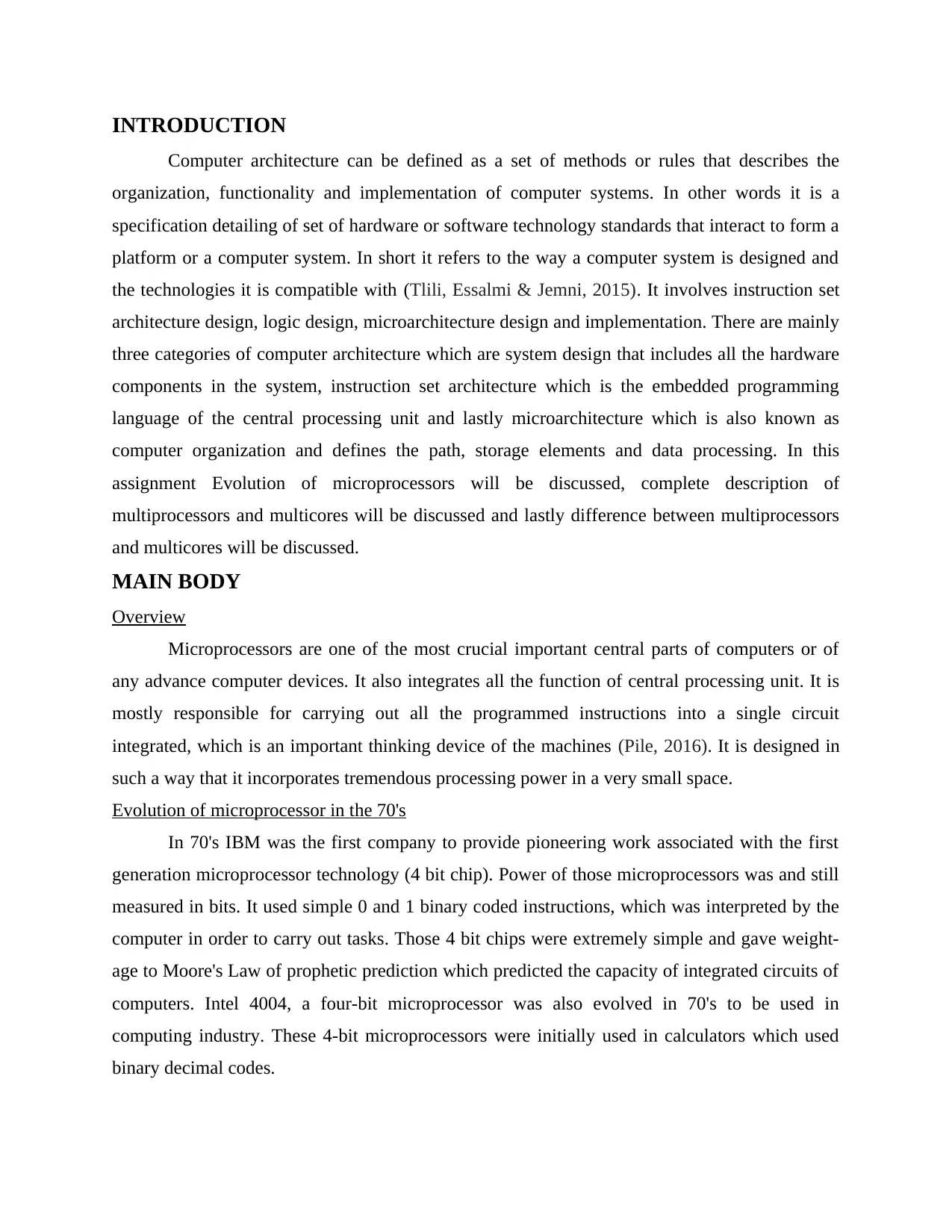
INTRODUCTION
Computer architecture can be defined as a set of methods or rules that describes the
organization, functionality and implementation of computer systems. In other words it is a
specification detailing of set of hardware or software technology standards that interact to form a
platform or a computer system. In short it refers to the way a computer system is designed and
the technologies it is compatible with (Tlili, Essalmi & Jemni, 2015). It involves instruction set
architecture design, logic design, microarchitecture design and implementation. There are mainly
three categories of computer architecture which are system design that includes all the hardware
components in the system, instruction set architecture which is the embedded programming
language of the central processing unit and lastly microarchitecture which is also known as
computer organization and defines the path, storage elements and data processing. In this
assignment Evolution of microprocessors will be discussed, complete description of
multiprocessors and multicores will be discussed and lastly difference between multiprocessors
and multicores will be discussed.
MAIN BODY
Overview
Microprocessors are one of the most crucial important central parts of computers or of
any advance computer devices. It also integrates all the function of central processing unit. It is
mostly responsible for carrying out all the programmed instructions into a single circuit
integrated, which is an important thinking device of the machines (Pile, 2016). It is designed in
such a way that it incorporates tremendous processing power in a very small space.
Evolution of microprocessor in the 70's
In 70's IBM was the first company to provide pioneering work associated with the first
generation microprocessor technology (4 bit chip). Power of those microprocessors was and still
measured in bits. It used simple 0 and 1 binary coded instructions, which was interpreted by the
computer in order to carry out tasks. Those 4 bit chips were extremely simple and gave weight-
age to Moore's Law of prophetic prediction which predicted the capacity of integrated circuits of
computers. Intel 4004, a four-bit microprocessor was also evolved in 70's to be used in
computing industry. These 4-bit microprocessors were initially used in calculators which used
binary decimal codes.
Computer architecture can be defined as a set of methods or rules that describes the
organization, functionality and implementation of computer systems. In other words it is a
specification detailing of set of hardware or software technology standards that interact to form a
platform or a computer system. In short it refers to the way a computer system is designed and
the technologies it is compatible with (Tlili, Essalmi & Jemni, 2015). It involves instruction set
architecture design, logic design, microarchitecture design and implementation. There are mainly
three categories of computer architecture which are system design that includes all the hardware
components in the system, instruction set architecture which is the embedded programming
language of the central processing unit and lastly microarchitecture which is also known as
computer organization and defines the path, storage elements and data processing. In this
assignment Evolution of microprocessors will be discussed, complete description of
multiprocessors and multicores will be discussed and lastly difference between multiprocessors
and multicores will be discussed.
MAIN BODY
Overview
Microprocessors are one of the most crucial important central parts of computers or of
any advance computer devices. It also integrates all the function of central processing unit. It is
mostly responsible for carrying out all the programmed instructions into a single circuit
integrated, which is an important thinking device of the machines (Pile, 2016). It is designed in
such a way that it incorporates tremendous processing power in a very small space.
Evolution of microprocessor in the 70's
In 70's IBM was the first company to provide pioneering work associated with the first
generation microprocessor technology (4 bit chip). Power of those microprocessors was and still
measured in bits. It used simple 0 and 1 binary coded instructions, which was interpreted by the
computer in order to carry out tasks. Those 4 bit chips were extremely simple and gave weight-
age to Moore's Law of prophetic prediction which predicted the capacity of integrated circuits of
computers. Intel 4004, a four-bit microprocessor was also evolved in 70's to be used in
computing industry. These 4-bit microprocessors were initially used in calculators which used
binary decimal codes.
⊘ This is a preview!⊘
Do you want full access?
Subscribe today to unlock all pages.

Trusted by 1+ million students worldwide

Intel was the first to come as a forerunner in early microprocessor technology and
released their first 8-bit chipped microprocessor, i.e. the 8008 in 1972. Engineers involved in 4-
bit model were involved in designing and contributing ideas and specifications to this new
generation of 8-bit chip. Except Intel Mostek was also developing 8-bit processors which were
used to serve many automated PC's or other applications By this time many other companies
were also increasing their interest in microprocessor technology. In the mid of this decade Intel
introduced new 8080 microprocessors, which cached the eye of many engineers and computer
developers. These 8-bit microprocessors were used in printers, terminals and various other kinds
of automated machines (Kumar & et.al, 2016). Intel also worked on development of EPROM
(8748) and masked ROM (8048) which were used in low volume production systems.
After Intel's breakthrough of development in microprocessor technology 16-bit
microprocessors were developed. First 16-bit microprocessor were used in processors and many
other internal parts of computer systems. However, the era of 16 – bit chipped microprocessor
was short lived in the industry. First 16-bit microprocessor (National semiconductor) were
relatively slow as more advance semiconductors such as Motorola 6800 were already found and
used in Macintosh systems and various other systems. By the time 16-bit chips were trying to
live up to their potential 32 bit era had already begun to arrive. By this time many other
companies such as Hitachi, Motorola etc. had started developing microprocessors and used in
low end customer products in order to enhance their processing. These chips were used in central
processing units of the computers as well. They were also used in many external transistors
which required light emitting diode which not only increased their processing power but also
extended their battery life (Kenakin, 2015).
In 70's there was rapid progress in speed and size of the microprocessors which was mainly
fuelled by MOSFET technology and other expanding markets.
Evolution of microprocessor in the 80's
At the starting of 1980's development of 32- bit microprocessors was a full swing and had
begun to appear in the market to be used on the courtesy of Hewlett Packard and National
Semiconductors. Computers or desktop engineering devices entered a new phase with the
inception of 32 bit processing. These 32 bit microprocessors were relatively much more
advanced and fast and were looked upon as a forerunner of advance modern microprocessors.
These developed 32 bit microprocessors were this efficient that they are still used at many places
released their first 8-bit chipped microprocessor, i.e. the 8008 in 1972. Engineers involved in 4-
bit model were involved in designing and contributing ideas and specifications to this new
generation of 8-bit chip. Except Intel Mostek was also developing 8-bit processors which were
used to serve many automated PC's or other applications By this time many other companies
were also increasing their interest in microprocessor technology. In the mid of this decade Intel
introduced new 8080 microprocessors, which cached the eye of many engineers and computer
developers. These 8-bit microprocessors were used in printers, terminals and various other kinds
of automated machines (Kumar & et.al, 2016). Intel also worked on development of EPROM
(8748) and masked ROM (8048) which were used in low volume production systems.
After Intel's breakthrough of development in microprocessor technology 16-bit
microprocessors were developed. First 16-bit microprocessor were used in processors and many
other internal parts of computer systems. However, the era of 16 – bit chipped microprocessor
was short lived in the industry. First 16-bit microprocessor (National semiconductor) were
relatively slow as more advance semiconductors such as Motorola 6800 were already found and
used in Macintosh systems and various other systems. By the time 16-bit chips were trying to
live up to their potential 32 bit era had already begun to arrive. By this time many other
companies such as Hitachi, Motorola etc. had started developing microprocessors and used in
low end customer products in order to enhance their processing. These chips were used in central
processing units of the computers as well. They were also used in many external transistors
which required light emitting diode which not only increased their processing power but also
extended their battery life (Kenakin, 2015).
In 70's there was rapid progress in speed and size of the microprocessors which was mainly
fuelled by MOSFET technology and other expanding markets.
Evolution of microprocessor in the 80's
At the starting of 1980's development of 32- bit microprocessors was a full swing and had
begun to appear in the market to be used on the courtesy of Hewlett Packard and National
Semiconductors. Computers or desktop engineering devices entered a new phase with the
inception of 32 bit processing. These 32 bit microprocessors were relatively much more
advanced and fast and were looked upon as a forerunner of advance modern microprocessors.
These developed 32 bit microprocessors were this efficient that they are still used at many places
Paraphrase This Document
Need a fresh take? Get an instant paraphrase of this document with our AI Paraphraser
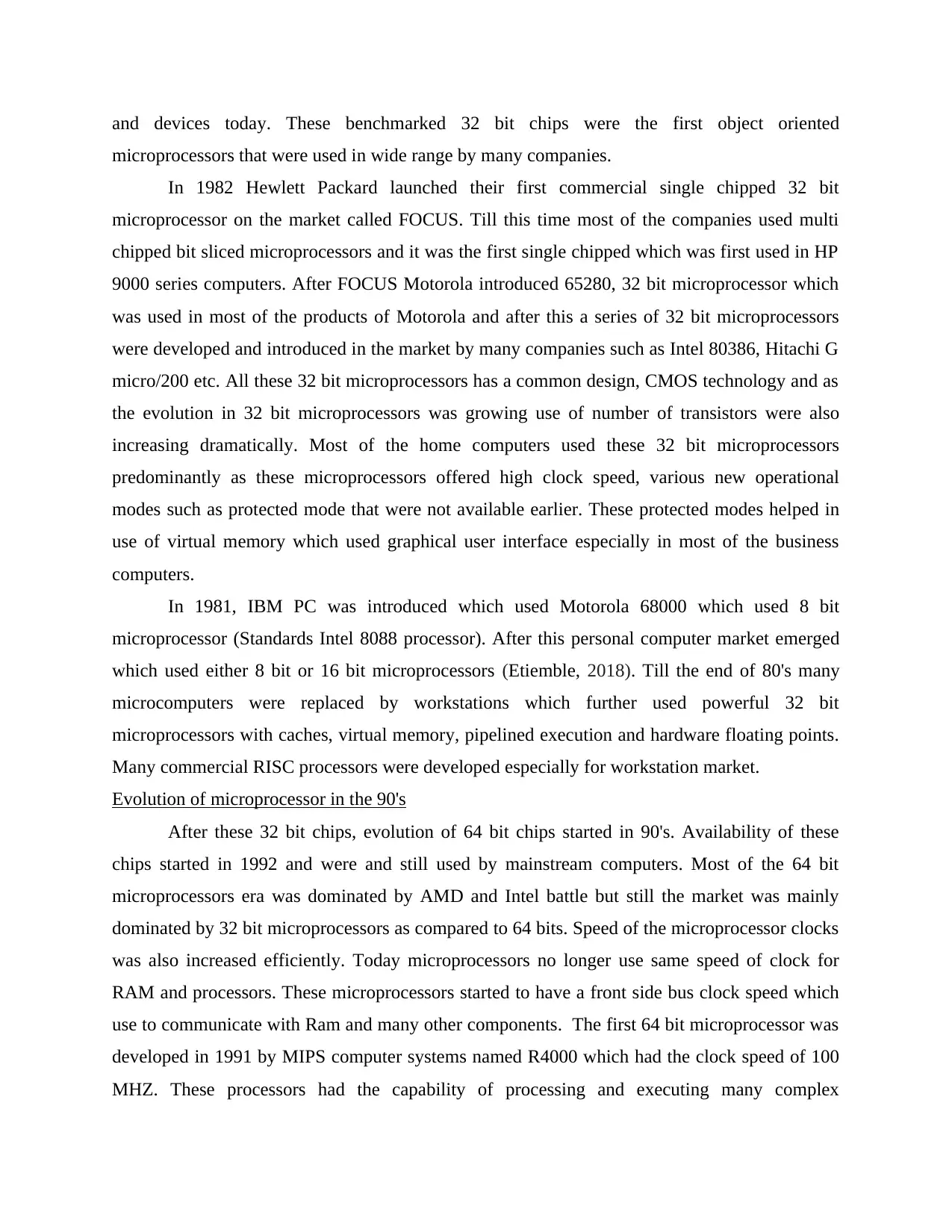
and devices today. These benchmarked 32 bit chips were the first object oriented
microprocessors that were used in wide range by many companies.
In 1982 Hewlett Packard launched their first commercial single chipped 32 bit
microprocessor on the market called FOCUS. Till this time most of the companies used multi
chipped bit sliced microprocessors and it was the first single chipped which was first used in HP
9000 series computers. After FOCUS Motorola introduced 65280, 32 bit microprocessor which
was used in most of the products of Motorola and after this a series of 32 bit microprocessors
were developed and introduced in the market by many companies such as Intel 80386, Hitachi G
micro/200 etc. All these 32 bit microprocessors has a common design, CMOS technology and as
the evolution in 32 bit microprocessors was growing use of number of transistors were also
increasing dramatically. Most of the home computers used these 32 bit microprocessors
predominantly as these microprocessors offered high clock speed, various new operational
modes such as protected mode that were not available earlier. These protected modes helped in
use of virtual memory which used graphical user interface especially in most of the business
computers.
In 1981, IBM PC was introduced which used Motorola 68000 which used 8 bit
microprocessor (Standards Intel 8088 processor). After this personal computer market emerged
which used either 8 bit or 16 bit microprocessors (Etiemble, 2018). Till the end of 80's many
microcomputers were replaced by workstations which further used powerful 32 bit
microprocessors with caches, virtual memory, pipelined execution and hardware floating points.
Many commercial RISC processors were developed especially for workstation market.
Evolution of microprocessor in the 90's
After these 32 bit chips, evolution of 64 bit chips started in 90's. Availability of these
chips started in 1992 and were and still used by mainstream computers. Most of the 64 bit
microprocessors era was dominated by AMD and Intel battle but still the market was mainly
dominated by 32 bit microprocessors as compared to 64 bits. Speed of the microprocessor clocks
was also increased efficiently. Today microprocessors no longer use same speed of clock for
RAM and processors. These microprocessors started to have a front side bus clock speed which
use to communicate with Ram and many other components. The first 64 bit microprocessor was
developed in 1991 by MIPS computer systems named R4000 which had the clock speed of 100
MHZ. These processors had the capability of processing and executing many complex
microprocessors that were used in wide range by many companies.
In 1982 Hewlett Packard launched their first commercial single chipped 32 bit
microprocessor on the market called FOCUS. Till this time most of the companies used multi
chipped bit sliced microprocessors and it was the first single chipped which was first used in HP
9000 series computers. After FOCUS Motorola introduced 65280, 32 bit microprocessor which
was used in most of the products of Motorola and after this a series of 32 bit microprocessors
were developed and introduced in the market by many companies such as Intel 80386, Hitachi G
micro/200 etc. All these 32 bit microprocessors has a common design, CMOS technology and as
the evolution in 32 bit microprocessors was growing use of number of transistors were also
increasing dramatically. Most of the home computers used these 32 bit microprocessors
predominantly as these microprocessors offered high clock speed, various new operational
modes such as protected mode that were not available earlier. These protected modes helped in
use of virtual memory which used graphical user interface especially in most of the business
computers.
In 1981, IBM PC was introduced which used Motorola 68000 which used 8 bit
microprocessor (Standards Intel 8088 processor). After this personal computer market emerged
which used either 8 bit or 16 bit microprocessors (Etiemble, 2018). Till the end of 80's many
microcomputers were replaced by workstations which further used powerful 32 bit
microprocessors with caches, virtual memory, pipelined execution and hardware floating points.
Many commercial RISC processors were developed especially for workstation market.
Evolution of microprocessor in the 90's
After these 32 bit chips, evolution of 64 bit chips started in 90's. Availability of these
chips started in 1992 and were and still used by mainstream computers. Most of the 64 bit
microprocessors era was dominated by AMD and Intel battle but still the market was mainly
dominated by 32 bit microprocessors as compared to 64 bits. Speed of the microprocessor clocks
was also increased efficiently. Today microprocessors no longer use same speed of clock for
RAM and processors. These microprocessors started to have a front side bus clock speed which
use to communicate with Ram and many other components. The first 64 bit microprocessor was
developed in 1991 by MIPS computer systems named R4000 which had the clock speed of 100
MHZ. These processors had the capability of processing and executing many complex
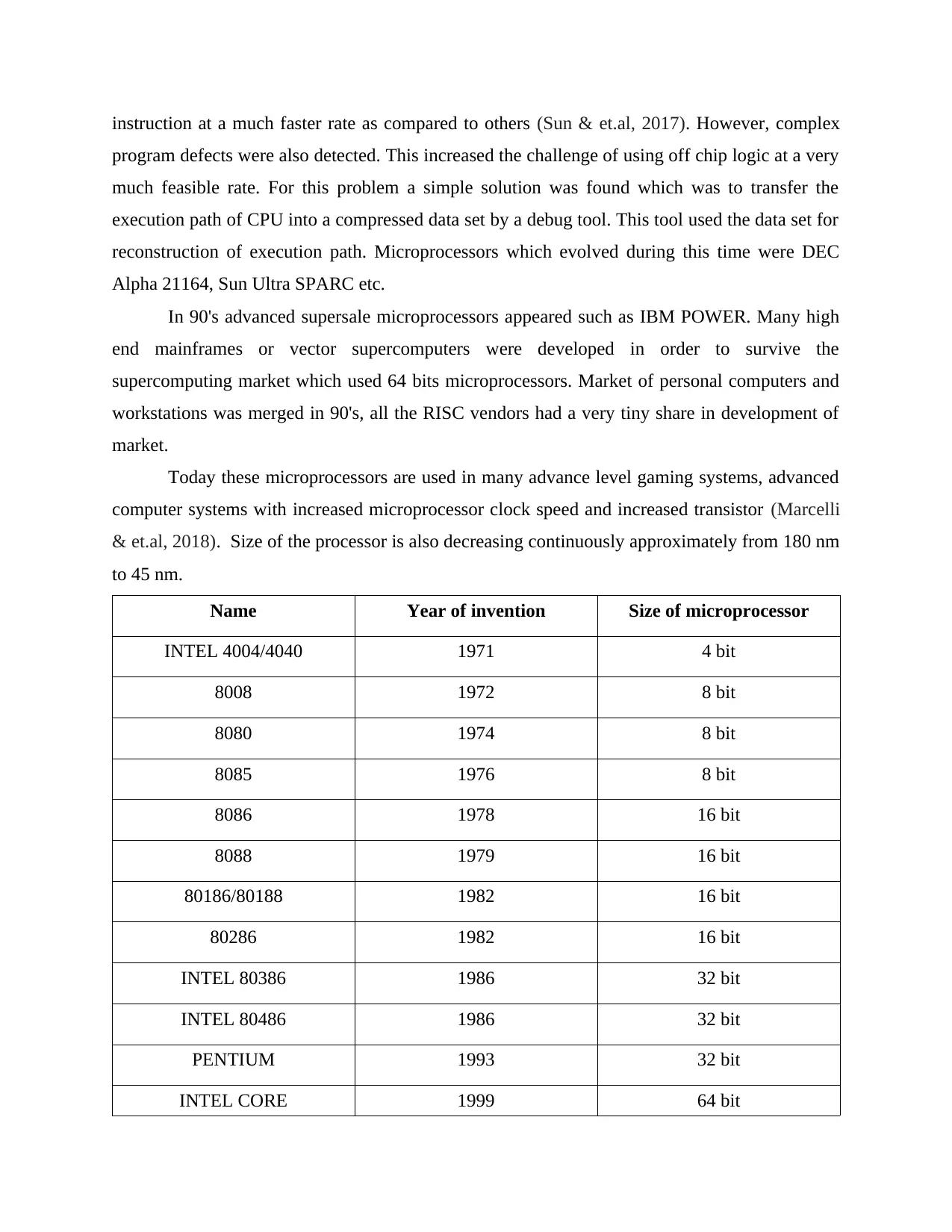
instruction at a much faster rate as compared to others (Sun & et.al, 2017). However, complex
program defects were also detected. This increased the challenge of using off chip logic at a very
much feasible rate. For this problem a simple solution was found which was to transfer the
execution path of CPU into a compressed data set by a debug tool. This tool used the data set for
reconstruction of execution path. Microprocessors which evolved during this time were DEC
Alpha 21164, Sun Ultra SPARC etc.
In 90's advanced supersale microprocessors appeared such as IBM POWER. Many high
end mainframes or vector supercomputers were developed in order to survive the
supercomputing market which used 64 bits microprocessors. Market of personal computers and
workstations was merged in 90's, all the RISC vendors had a very tiny share in development of
market.
Today these microprocessors are used in many advance level gaming systems, advanced
computer systems with increased microprocessor clock speed and increased transistor (Marcelli
& et.al, 2018). Size of the processor is also decreasing continuously approximately from 180 nm
to 45 nm.
Name Year of invention Size of microprocessor
INTEL 4004/4040 1971 4 bit
8008 1972 8 bit
8080 1974 8 bit
8085 1976 8 bit
8086 1978 16 bit
8088 1979 16 bit
80186/80188 1982 16 bit
80286 1982 16 bit
INTEL 80386 1986 32 bit
INTEL 80486 1986 32 bit
PENTIUM 1993 32 bit
INTEL CORE 1999 64 bit
program defects were also detected. This increased the challenge of using off chip logic at a very
much feasible rate. For this problem a simple solution was found which was to transfer the
execution path of CPU into a compressed data set by a debug tool. This tool used the data set for
reconstruction of execution path. Microprocessors which evolved during this time were DEC
Alpha 21164, Sun Ultra SPARC etc.
In 90's advanced supersale microprocessors appeared such as IBM POWER. Many high
end mainframes or vector supercomputers were developed in order to survive the
supercomputing market which used 64 bits microprocessors. Market of personal computers and
workstations was merged in 90's, all the RISC vendors had a very tiny share in development of
market.
Today these microprocessors are used in many advance level gaming systems, advanced
computer systems with increased microprocessor clock speed and increased transistor (Marcelli
& et.al, 2018). Size of the processor is also decreasing continuously approximately from 180 nm
to 45 nm.
Name Year of invention Size of microprocessor
INTEL 4004/4040 1971 4 bit
8008 1972 8 bit
8080 1974 8 bit
8085 1976 8 bit
8086 1978 16 bit
8088 1979 16 bit
80186/80188 1982 16 bit
80286 1982 16 bit
INTEL 80386 1986 32 bit
INTEL 80486 1986 32 bit
PENTIUM 1993 32 bit
INTEL CORE 1999 64 bit
⊘ This is a preview!⊘
Do you want full access?
Subscribe today to unlock all pages.

Trusted by 1+ million students worldwide
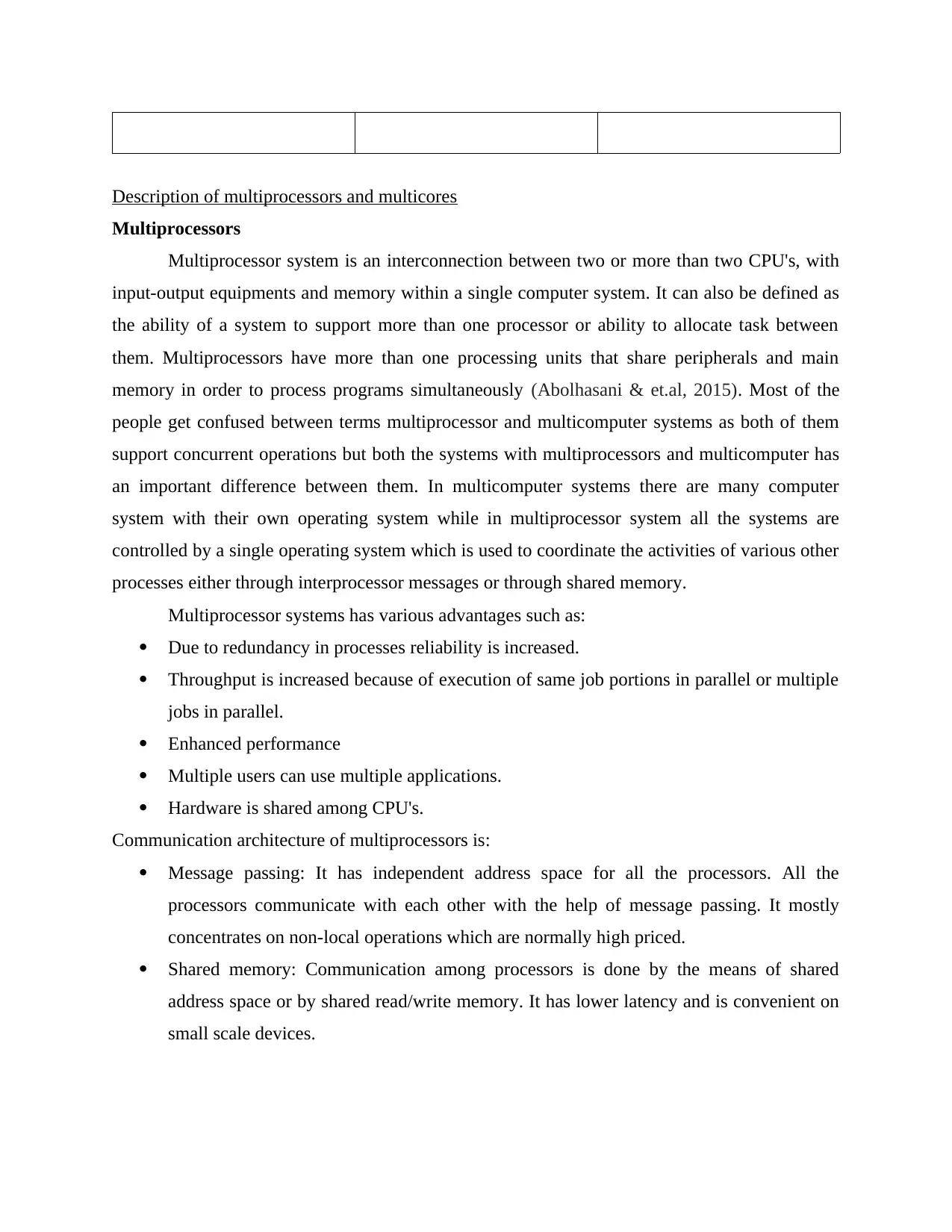
Description of multiprocessors and multicores
Multiprocessors
Multiprocessor system is an interconnection between two or more than two CPU's, with
input-output equipments and memory within a single computer system. It can also be defined as
the ability of a system to support more than one processor or ability to allocate task between
them. Multiprocessors have more than one processing units that share peripherals and main
memory in order to process programs simultaneously (Abolhasani & et.al, 2015). Most of the
people get confused between terms multiprocessor and multicomputer systems as both of them
support concurrent operations but both the systems with multiprocessors and multicomputer has
an important difference between them. In multicomputer systems there are many computer
system with their own operating system while in multiprocessor system all the systems are
controlled by a single operating system which is used to coordinate the activities of various other
processes either through interprocessor messages or through shared memory.
Multiprocessor systems has various advantages such as:
Due to redundancy in processes reliability is increased.
Throughput is increased because of execution of same job portions in parallel or multiple
jobs in parallel.
Enhanced performance
Multiple users can use multiple applications.
Hardware is shared among CPU's.
Communication architecture of multiprocessors is:
Message passing: It has independent address space for all the processors. All the
processors communicate with each other with the help of message passing. It mostly
concentrates on non-local operations which are normally high priced.
Shared memory: Communication among processors is done by the means of shared
address space or by shared read/write memory. It has lower latency and is convenient on
small scale devices.
Multiprocessors
Multiprocessor system is an interconnection between two or more than two CPU's, with
input-output equipments and memory within a single computer system. It can also be defined as
the ability of a system to support more than one processor or ability to allocate task between
them. Multiprocessors have more than one processing units that share peripherals and main
memory in order to process programs simultaneously (Abolhasani & et.al, 2015). Most of the
people get confused between terms multiprocessor and multicomputer systems as both of them
support concurrent operations but both the systems with multiprocessors and multicomputer has
an important difference between them. In multicomputer systems there are many computer
system with their own operating system while in multiprocessor system all the systems are
controlled by a single operating system which is used to coordinate the activities of various other
processes either through interprocessor messages or through shared memory.
Multiprocessor systems has various advantages such as:
Due to redundancy in processes reliability is increased.
Throughput is increased because of execution of same job portions in parallel or multiple
jobs in parallel.
Enhanced performance
Multiple users can use multiple applications.
Hardware is shared among CPU's.
Communication architecture of multiprocessors is:
Message passing: It has independent address space for all the processors. All the
processors communicate with each other with the help of message passing. It mostly
concentrates on non-local operations which are normally high priced.
Shared memory: Communication among processors is done by the means of shared
address space or by shared read/write memory. It has lower latency and is convenient on
small scale devices.
Paraphrase This Document
Need a fresh take? Get an instant paraphrase of this document with our AI Paraphraser
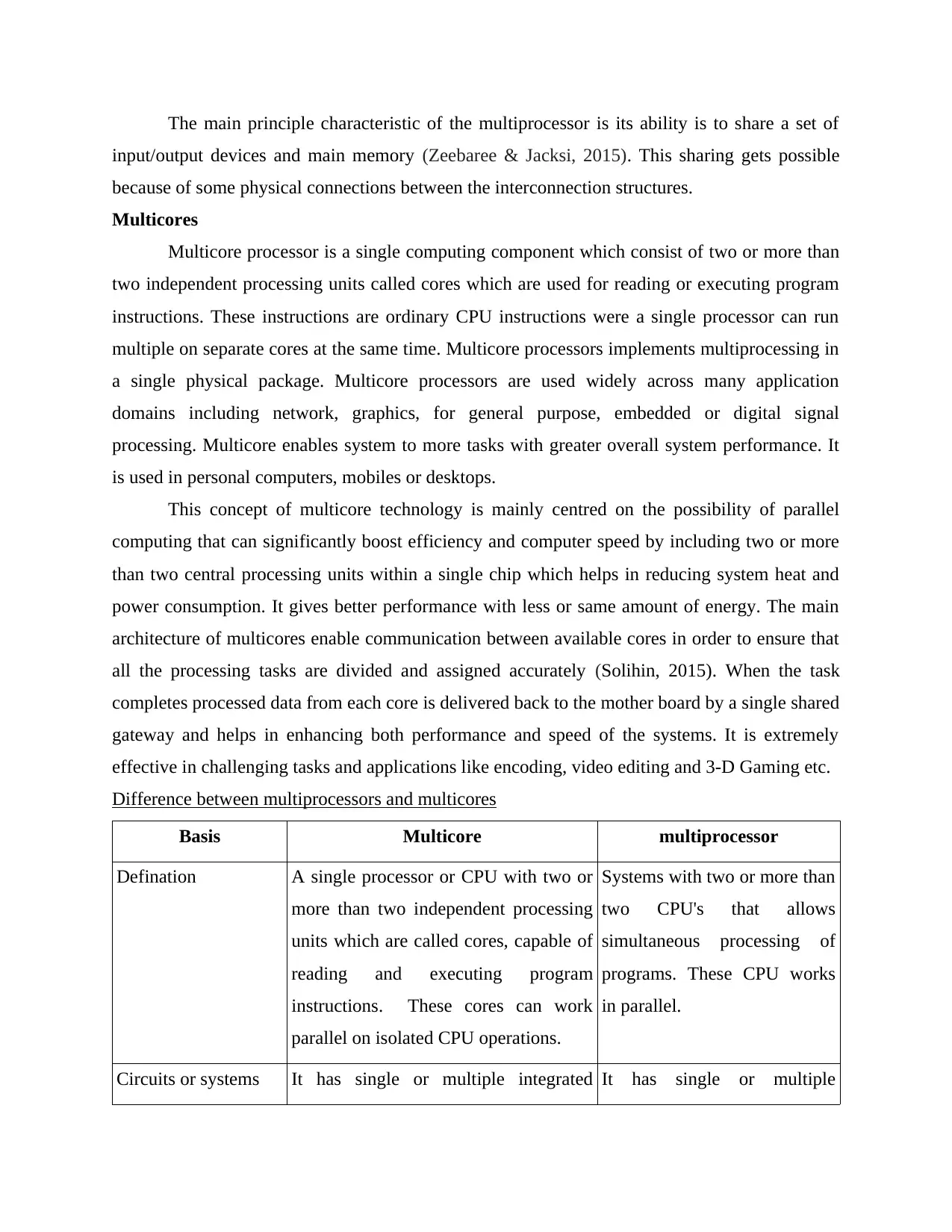
The main principle characteristic of the multiprocessor is its ability is to share a set of
input/output devices and main memory (Zeebaree & Jacksi, 2015). This sharing gets possible
because of some physical connections between the interconnection structures.
Multicores
Multicore processor is a single computing component which consist of two or more than
two independent processing units called cores which are used for reading or executing program
instructions. These instructions are ordinary CPU instructions were a single processor can run
multiple on separate cores at the same time. Multicore processors implements multiprocessing in
a single physical package. Multicore processors are used widely across many application
domains including network, graphics, for general purpose, embedded or digital signal
processing. Multicore enables system to more tasks with greater overall system performance. It
is used in personal computers, mobiles or desktops.
This concept of multicore technology is mainly centred on the possibility of parallel
computing that can significantly boost efficiency and computer speed by including two or more
than two central processing units within a single chip which helps in reducing system heat and
power consumption. It gives better performance with less or same amount of energy. The main
architecture of multicores enable communication between available cores in order to ensure that
all the processing tasks are divided and assigned accurately (Solihin, 2015). When the task
completes processed data from each core is delivered back to the mother board by a single shared
gateway and helps in enhancing both performance and speed of the systems. It is extremely
effective in challenging tasks and applications like encoding, video editing and 3-D Gaming etc.
Difference between multiprocessors and multicores
Basis Multicore multiprocessor
Defination A single processor or CPU with two or
more than two independent processing
units which are called cores, capable of
reading and executing program
instructions. These cores can work
parallel on isolated CPU operations.
Systems with two or more than
two CPU's that allows
simultaneous processing of
programs. These CPU works
in parallel.
Circuits or systems It has single or multiple integrated It has single or multiple
input/output devices and main memory (Zeebaree & Jacksi, 2015). This sharing gets possible
because of some physical connections between the interconnection structures.
Multicores
Multicore processor is a single computing component which consist of two or more than
two independent processing units called cores which are used for reading or executing program
instructions. These instructions are ordinary CPU instructions were a single processor can run
multiple on separate cores at the same time. Multicore processors implements multiprocessing in
a single physical package. Multicore processors are used widely across many application
domains including network, graphics, for general purpose, embedded or digital signal
processing. Multicore enables system to more tasks with greater overall system performance. It
is used in personal computers, mobiles or desktops.
This concept of multicore technology is mainly centred on the possibility of parallel
computing that can significantly boost efficiency and computer speed by including two or more
than two central processing units within a single chip which helps in reducing system heat and
power consumption. It gives better performance with less or same amount of energy. The main
architecture of multicores enable communication between available cores in order to ensure that
all the processing tasks are divided and assigned accurately (Solihin, 2015). When the task
completes processed data from each core is delivered back to the mother board by a single shared
gateway and helps in enhancing both performance and speed of the systems. It is extremely
effective in challenging tasks and applications like encoding, video editing and 3-D Gaming etc.
Difference between multiprocessors and multicores
Basis Multicore multiprocessor
Defination A single processor or CPU with two or
more than two independent processing
units which are called cores, capable of
reading and executing program
instructions. These cores can work
parallel on isolated CPU operations.
Systems with two or more than
two CPU's that allows
simultaneous processing of
programs. These CPU works
in parallel.
Circuits or systems It has single or multiple integrated It has single or multiple
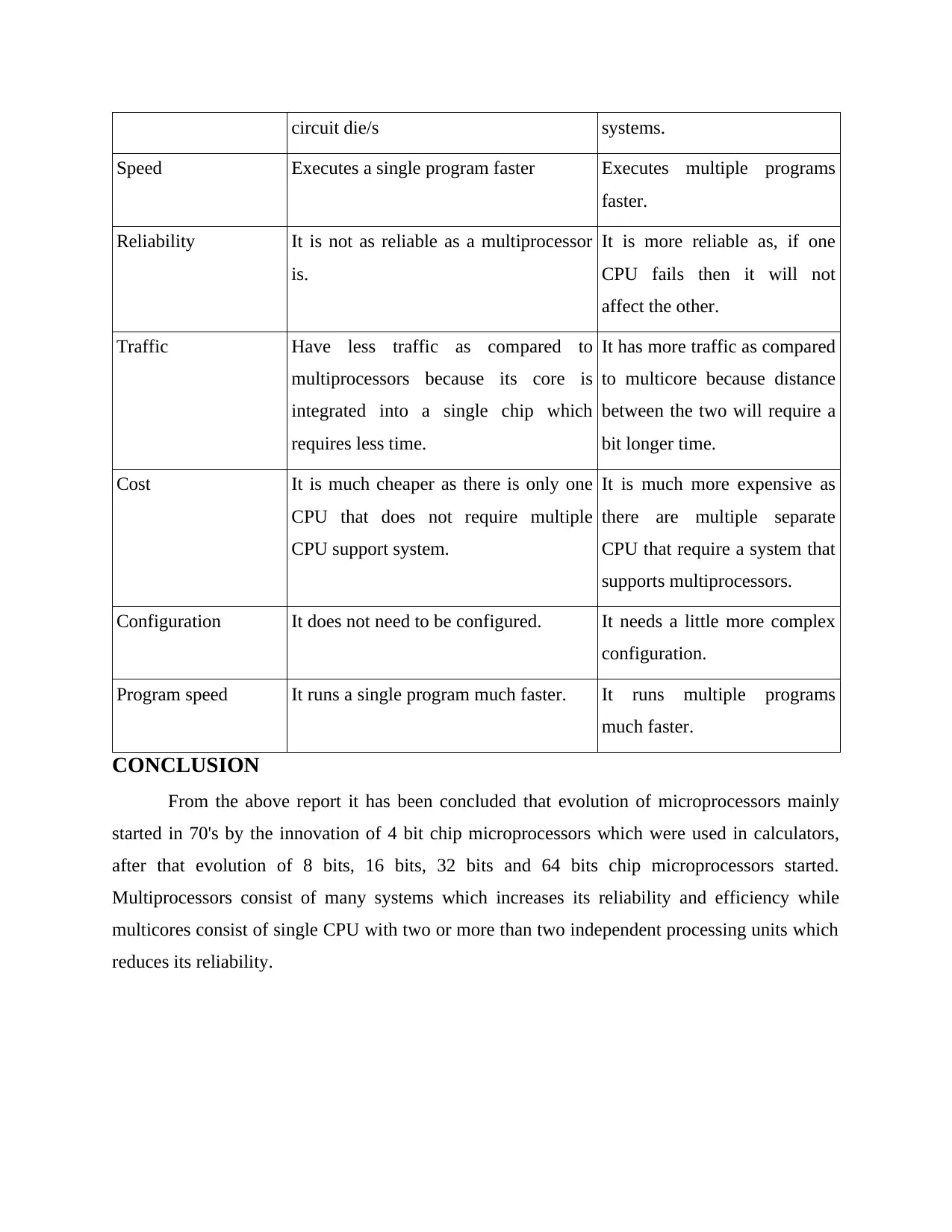
circuit die/s systems.
Speed Executes a single program faster Executes multiple programs
faster.
Reliability It is not as reliable as a multiprocessor
is.
It is more reliable as, if one
CPU fails then it will not
affect the other.
Traffic Have less traffic as compared to
multiprocessors because its core is
integrated into a single chip which
requires less time.
It has more traffic as compared
to multicore because distance
between the two will require a
bit longer time.
Cost It is much cheaper as there is only one
CPU that does not require multiple
CPU support system.
It is much more expensive as
there are multiple separate
CPU that require a system that
supports multiprocessors.
Configuration It does not need to be configured. It needs a little more complex
configuration.
Program speed It runs a single program much faster. It runs multiple programs
much faster.
CONCLUSION
From the above report it has been concluded that evolution of microprocessors mainly
started in 70's by the innovation of 4 bit chip microprocessors which were used in calculators,
after that evolution of 8 bits, 16 bits, 32 bits and 64 bits chip microprocessors started.
Multiprocessors consist of many systems which increases its reliability and efficiency while
multicores consist of single CPU with two or more than two independent processing units which
reduces its reliability.
Speed Executes a single program faster Executes multiple programs
faster.
Reliability It is not as reliable as a multiprocessor
is.
It is more reliable as, if one
CPU fails then it will not
affect the other.
Traffic Have less traffic as compared to
multiprocessors because its core is
integrated into a single chip which
requires less time.
It has more traffic as compared
to multicore because distance
between the two will require a
bit longer time.
Cost It is much cheaper as there is only one
CPU that does not require multiple
CPU support system.
It is much more expensive as
there are multiple separate
CPU that require a system that
supports multiprocessors.
Configuration It does not need to be configured. It needs a little more complex
configuration.
Program speed It runs a single program much faster. It runs multiple programs
much faster.
CONCLUSION
From the above report it has been concluded that evolution of microprocessors mainly
started in 70's by the innovation of 4 bit chip microprocessors which were used in calculators,
after that evolution of 8 bits, 16 bits, 32 bits and 64 bits chip microprocessors started.
Multiprocessors consist of many systems which increases its reliability and efficiency while
multicores consist of single CPU with two or more than two independent processing units which
reduces its reliability.
⊘ This is a preview!⊘
Do you want full access?
Subscribe today to unlock all pages.

Trusted by 1+ million students worldwide
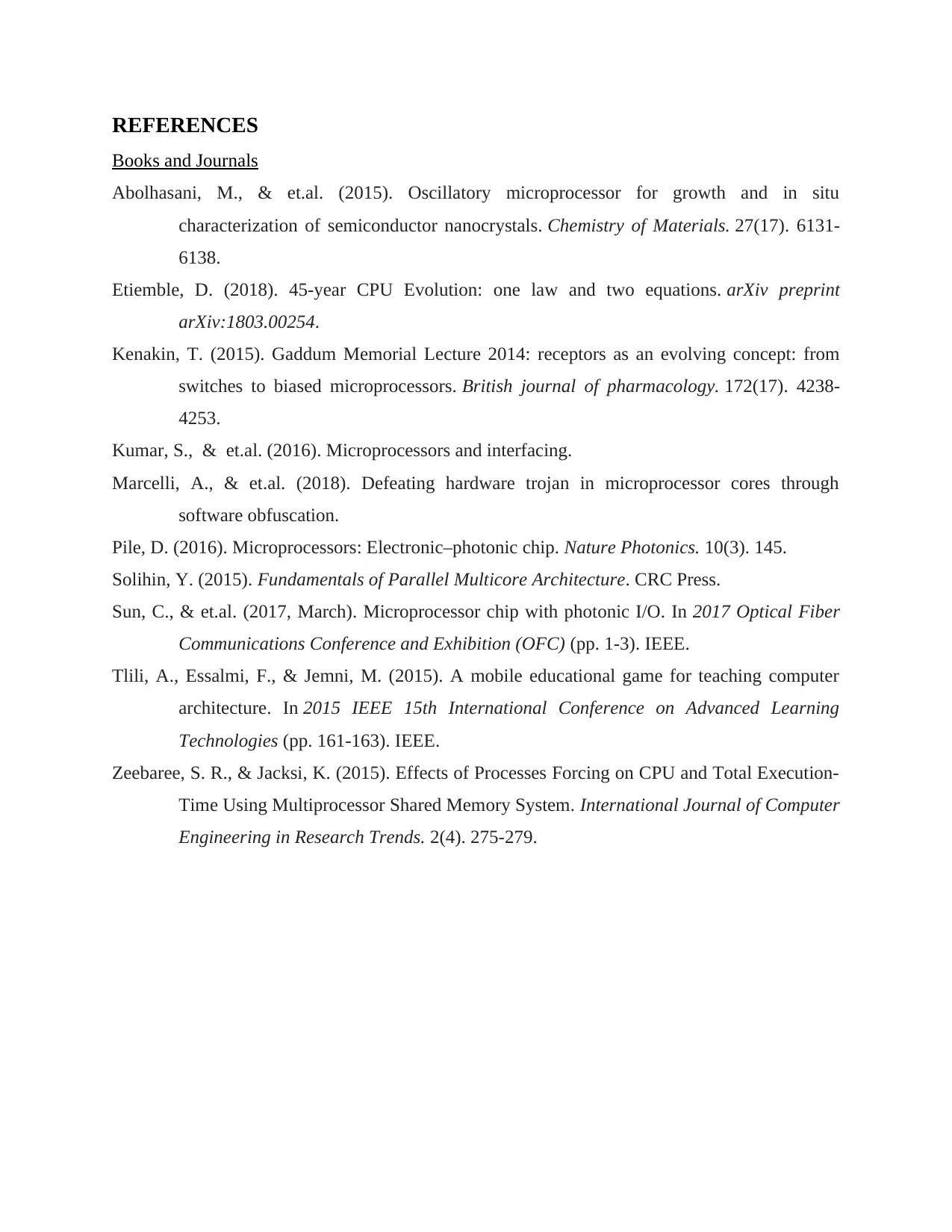
REFERENCES
Books and Journals
Abolhasani, M., & et.al. (2015). Oscillatory microprocessor for growth and in situ
characterization of semiconductor nanocrystals. Chemistry of Materials. 27(17). 6131-
6138.
Etiemble, D. (2018). 45-year CPU Evolution: one law and two equations. arXiv preprint
arXiv:1803.00254.
Kenakin, T. (2015). Gaddum Memorial Lecture 2014: receptors as an evolving concept: from
switches to biased microprocessors. British journal of pharmacology. 172(17). 4238-
4253.
Kumar, S., & et.al. (2016). Microprocessors and interfacing.
Marcelli, A., & et.al. (2018). Defeating hardware trojan in microprocessor cores through
software obfuscation.
Pile, D. (2016). Microprocessors: Electronic–photonic chip. Nature Photonics. 10(3). 145.
Solihin, Y. (2015). Fundamentals of Parallel Multicore Architecture. CRC Press.
Sun, C., & et.al. (2017, March). Microprocessor chip with photonic I/O. In 2017 Optical Fiber
Communications Conference and Exhibition (OFC) (pp. 1-3). IEEE.
Tlili, A., Essalmi, F., & Jemni, M. (2015). A mobile educational game for teaching computer
architecture. In 2015 IEEE 15th International Conference on Advanced Learning
Technologies (pp. 161-163). IEEE.
Zeebaree, S. R., & Jacksi, K. (2015). Effects of Processes Forcing on CPU and Total Execution-
Time Using Multiprocessor Shared Memory System. International Journal of Computer
Engineering in Research Trends. 2(4). 275-279.
Books and Journals
Abolhasani, M., & et.al. (2015). Oscillatory microprocessor for growth and in situ
characterization of semiconductor nanocrystals. Chemistry of Materials. 27(17). 6131-
6138.
Etiemble, D. (2018). 45-year CPU Evolution: one law and two equations. arXiv preprint
arXiv:1803.00254.
Kenakin, T. (2015). Gaddum Memorial Lecture 2014: receptors as an evolving concept: from
switches to biased microprocessors. British journal of pharmacology. 172(17). 4238-
4253.
Kumar, S., & et.al. (2016). Microprocessors and interfacing.
Marcelli, A., & et.al. (2018). Defeating hardware trojan in microprocessor cores through
software obfuscation.
Pile, D. (2016). Microprocessors: Electronic–photonic chip. Nature Photonics. 10(3). 145.
Solihin, Y. (2015). Fundamentals of Parallel Multicore Architecture. CRC Press.
Sun, C., & et.al. (2017, March). Microprocessor chip with photonic I/O. In 2017 Optical Fiber
Communications Conference and Exhibition (OFC) (pp. 1-3). IEEE.
Tlili, A., Essalmi, F., & Jemni, M. (2015). A mobile educational game for teaching computer
architecture. In 2015 IEEE 15th International Conference on Advanced Learning
Technologies (pp. 161-163). IEEE.
Zeebaree, S. R., & Jacksi, K. (2015). Effects of Processes Forcing on CPU and Total Execution-
Time Using Multiprocessor Shared Memory System. International Journal of Computer
Engineering in Research Trends. 2(4). 275-279.
1 out of 10
Related Documents
Your All-in-One AI-Powered Toolkit for Academic Success.
+13062052269
info@desklib.com
Available 24*7 on WhatsApp / Email
![[object Object]](/_next/static/media/star-bottom.7253800d.svg)
Unlock your academic potential
Copyright © 2020–2025 A2Z Services. All Rights Reserved. Developed and managed by ZUCOL.





